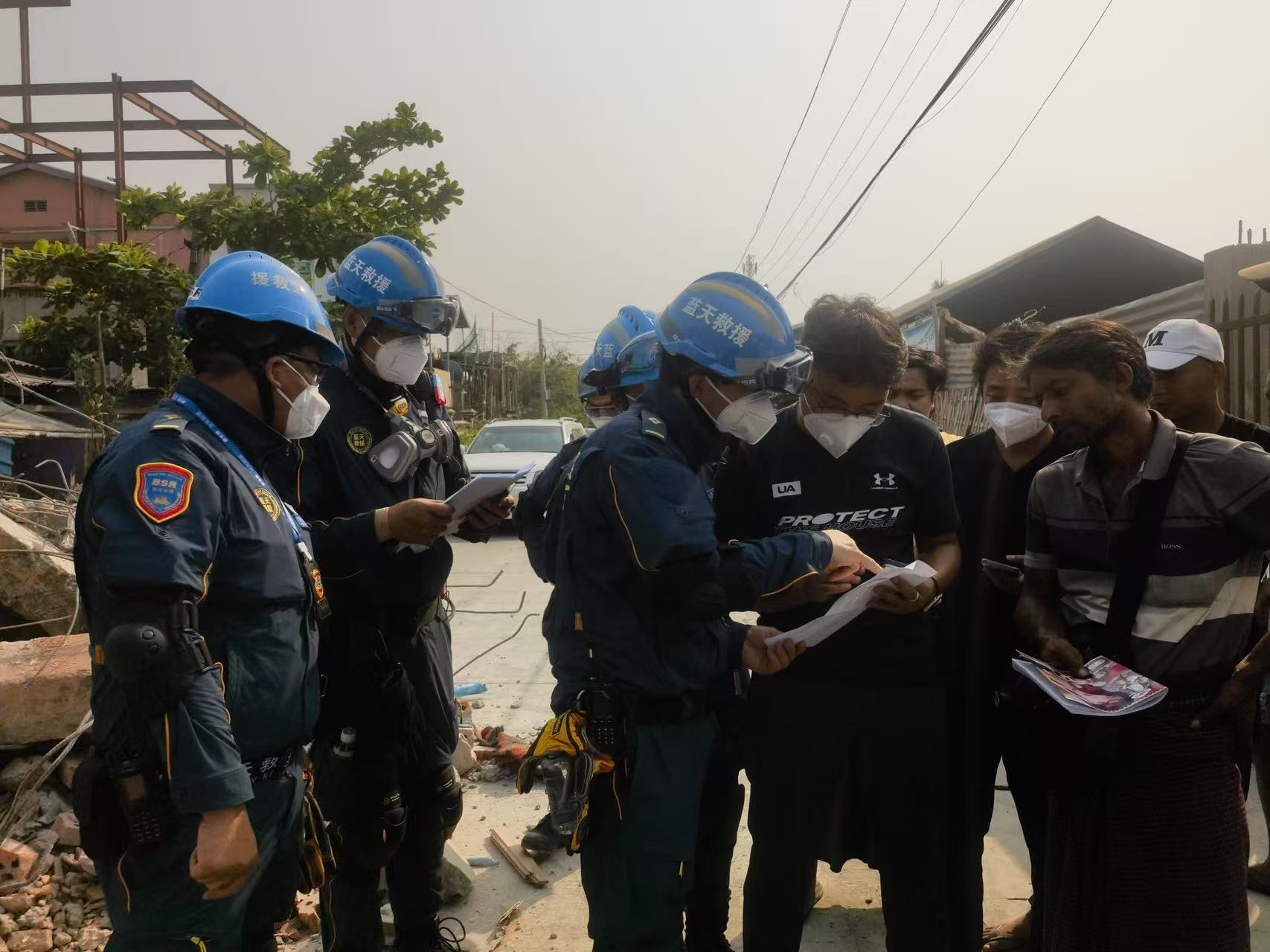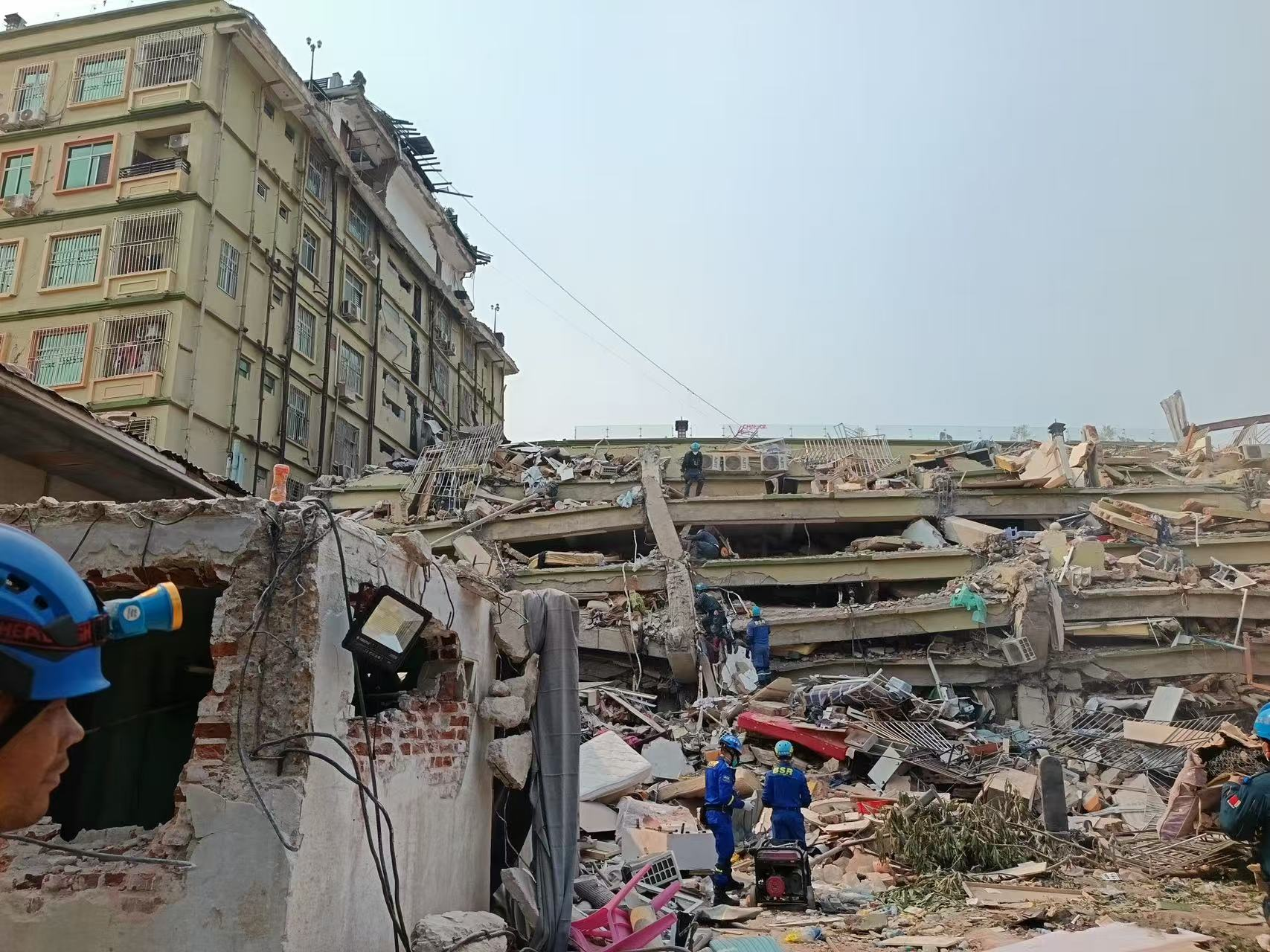At 14:20 on March 28, a powerful earthquake with a magnitude of 7.9 struck Sagaing Region, Myanmar. The focal depth was 30 kilometers, and this was the strongest earthquake Myanmar had experienced in nearly a hundred years. As of April 14, the earthquake had caused 3,706 deaths, 5,027 injuries, and 130 people missing in Myanmar. In severely affected areas such as Mandalay Region and Sagaing Region, more than 41,000 houses had collapsed, and the infrastructure had been severely damaged. As a representative of China's civil rescue forces, the Chinese Blue Sky Rescue Team responded rapidly, carried out life rescue operations across national borders, and interpreted the volunteer spirit of "humanity, fraternity, and dedication" with their professionalism and sweat.
Emergency Dispatch: 44 team members rushed to the disaster area day and night.
After the earthquake occurred, the Yunnan team of the Chinese Blue Sky Rescue Team immediately activated the emergency response mechanism. On the morning of March 29, the first batch of 16 team members, carrying 19 types of professional rescue equipment, left the country through the Ruili Port in Yunnan. They walked through the collapsed sections of the border and reached the epicenter area in Mandalay Region overnight. On April 1, the Yunnan team dispatched an additional 20 people in two batches to rush to the rescue by plane. They carried multiple sets of life detectors, demolition tools and other equipment. After meeting with the team members on the front line, they quickly engaged in the search and rescue operation. At the same time, 8 team members of the Baoshan Blue Sky Rescue Team in Shanghai set off from Hangzhou Xiaoshan International Airport on the evening of March 29 and became the first civil rescue team from the Shanghai area in China to arrive at the earthquake-stricken area.


In severely affected areas such as the Sky Apartment in Mandalay and the Baiyun Hotel, the members of the Blue Sky Rescue Team worked continuously in high temperatures exceeding 40℃ while wearing thick protective suits. "After arriving at the scene, we didn't take a rest and directly entered the areas with the most severe damage. Many collapsed buildings hadn't been searched yet. Time is of the essence when it comes to saving lives," recalled Zhu Minyun, the captain of the Yunnan team. The team members overcame the language barrier, collaborated with local volunteers with the help of translation software, and carefully searched for signs of life inch by inch in the ruins.

Race Against Death: Holding Up the Hope of Life in the Ruins
At the Great Wall Hotel in Mandalay, the Blue Sky Rescue Team carried out a joint operation with the Chinese Rescue Team and the 公羊 Rescue Team, and successfully rescued a female survivor who had been trapped for 40 hours. At the Buddhist Studies Auditorium, the Hunan Yuelu Blue Sky Rescue Team detected a pregnant woman with a life detector. After 5 hours of demolition work, they safely rescued her. In 6 days, the Blue Sky Rescue Team has searched and investigated a total of 287,000 square meters of buildings, assisted in clearing the collapsed ruins, successfully rescued several survivors, and transferred the bodies of 4 victims. "Every time we hear the signal from the life detector, we get excited," said Chen Yu, a member of the Shanghai team. Despite the fact that the high temperature caused the equipment to overheat frequently, the team members still insisted on rotating every 30 minutes to ensure that the rescue operation would not be interrupted. At the North District of the Confucian School in Mandalay, after the team members found that the teaching building had collapsed, they used a snake-eye detector and hydraulic demolition tools. It took them 12 hours to successfully rescue 3 trapped teachers and students.

Facing Numerous Challenges: High Temperatures, Aftershocks and the Threat of the Epidemic
During the rescue process, the Blue Sky Rescue Team faced multiple challenges. The continuous high temperature in the disaster area sharply increased the risk of dehydration for team members. Some team members still insisted on working even though they showed symptoms of heatstroke. Aftershocks occurred constantly (as of April 2, a total of 54 aftershocks had been recorded), and secondary collapses could occur at any time. In addition, the sanitary conditions in the disaster area deteriorated, and the risks of infectious diseases such as cholera and dengue fever increased. The team members assisted in epidemic prevention and disinfection during breaks in the search and rescue operation, and distributed 15,000 first aid kits and 10,000 mosquito nets to the disaster victims. The language communication barrier was also a major problem. The team members communicated with the local people through simple gestures and translation software. Li Na, a member of the Yunnan team, self-studied commonly used rescue-related words in Burmese and became the team's "temporary translator". The logistical support provided by overseas Chinese in Myanmar and Chinese-funded enterprises (such as vehicle dispatching and food supply) provided strong guarantees for the rescue operation.

International Collaboration: China's Strength Wins Global Praise
In this rescue operation, the Blue Sky Rescue Team worked closely with official forces such as the China Rescue Team and the China Red Cross International Rescue Team, forming an international rescue model of "government-civilian coordination." In Mandalay, the teams shared real-time data, jointly developed search and rescue plans, and utilized resources efficiently. Among the 100 million RMB worth of emergency aid materials provided by the Chinese government to Myanmar, the Blue Sky Rescue Team assisted in distributing 800 tents, 3,000 boxes of biscuits, and other supplies, directly benefiting over 20,000 disaster victims.
When meeting withthe Blue Sky rescue team members, Min Aung Hlaing, Chairman of Myanmar's State Administration Council, said, "The professionalism and efficiency of China's rescue forces are admirable. Your actions have deepened the friendship between the peoples of Myanmar and China." The UN Refugee Agency also highly praised the Blue Sky Rescue Team's work, stating that it "demonstrated international humanitarian spirit in complex environments."
Triumphant Return Home: Guardianship of Life Never Ceases
eturned to the Ruili Port, while the 8 members of the Shanghai team arrived in Shanghai on April 5. The team members did not take time to rest and immediately dove into equipment disinfection and rescue mission summaries. "Every international rescue is a chance to grow, and we will apply these experiences to future disaster responses," said Wang Qiang, deputy captain of the Yunnan team.
As a benchmark for China's civil rescue forces, the Blue Sky Rescue Team has participated in dozens of international rescue operations since its establishment in 2007, including the typhoon in the Philippines, the earthquake in Nepal, and the earthquake in Turkey. During the recent Myanmar earthquake rescue, they once again proved with action that in the face of disaster, national boundaries cannot block the belief that life comes first—and the presence of Chinese volunteers will always be the warmest beacon of hope.
